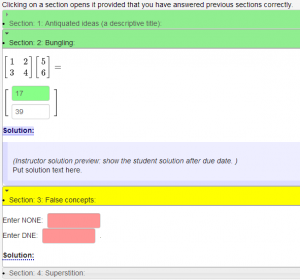Scaffolding1
Sequentially Revealed (Scaffolded) Problems
This PG code shows how to create multi-part questions that hide from students parts that have not yet been answered correct.
- File location in OPL: FortLewis/Authoring/Templates/Misc/Scaffolding1.pg
| PG problem file | Explanation |
|---|---|
|
Problem tagging: |
|
DOCUMENT();
loadMacros(
"PGstandard.pl",
"MathObjects.pl",
"compoundProblem5.pl",
"PGcourse.pl",
);
TEXT(beginproblem());
$showPartialCorrectAnswers = 1;
$scaffold = Scaffold();
INITIALIZE_SCAFFOLD('$scaffold');
$isInstructor = 0; # = 0 when students use it
TEXT(MODES(
HTML=>'Clicking on a section opens it
provided that you have answered previous sections correctly.',
TeX=>''));
|
Initialization:
Use the $isInstructor = ($envir{effectivePermissionLevel} >=
$envir{ALWAYS_SHOW_SOLUTION_PERMISSION_LEVEL});
to ensure that only users that always have permission to show correct answers can open all of the sections of the scaffolding without needing to enter correct answers. |
Context("Numeric");
$answer1a = Compute(11);
$answer1b = Compute(12);
Context()->texStrings;
DISPLAY_SECTION({
section=>1,
name=>"1: Antiquated ideas (a descriptive title)",
canshow =>1,
iscorrect=>$scaffold->requireCorrect(1,2),
} , <<'END_SECTION');
Continue the pattern: 7, 8, 9, 10,
\{SECTION_ANS($answer1a->cmp), $answer1a->ans_rule(3) \},
\{SECTION_ANS($answer1b->cmp), $answer1b->ans_rule(3)\}.
END_SECTION
SECTION_SOLUTION({section=>1},<<'END_SOLUTION');
$PAR
Put some text here for the solution to section 1.
END_SOLUTION
Context()->normalStrings;
|
Section 1:
Use The text that gets displayed to students starts at "Continue..."
Use It is also possible to provide a solution for each section. |
Context()->texStrings;
BEGIN_TEXT
Question text
$BR
$BR
Answer =
\{ ans_rule(20) \}
\{ AnswerFormatHelp("formulas") \}
END_TEXT
Context()->normalStrings;
|
Main Text: |
$showPartialCorrectAnswers = 1; ANS( $answer->cmp() ); |
Answer Evaluation: |
Context()->texStrings;
BEGIN_SOLUTION
${PAR}SOLUTION:${PAR}
Solution explanation goes here.
END_SOLUTION
Context()->normalStrings;
COMMENT('MathObject version.');
ENDDOCUMENT();
|
Solution: |
